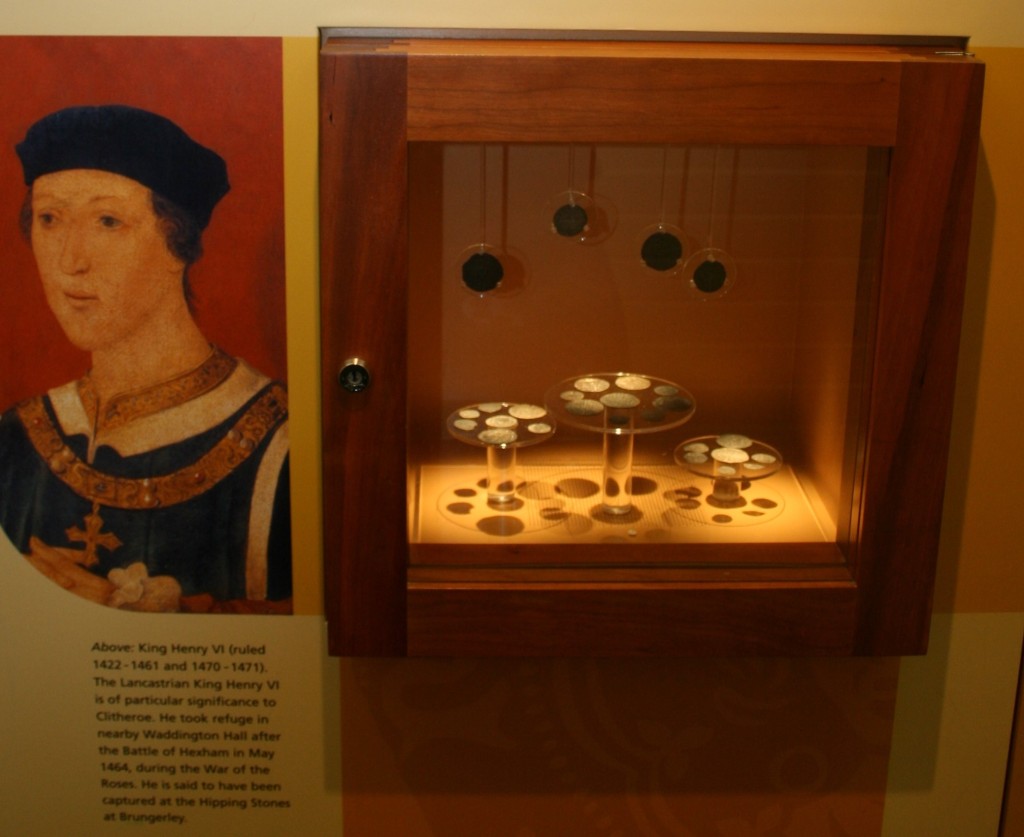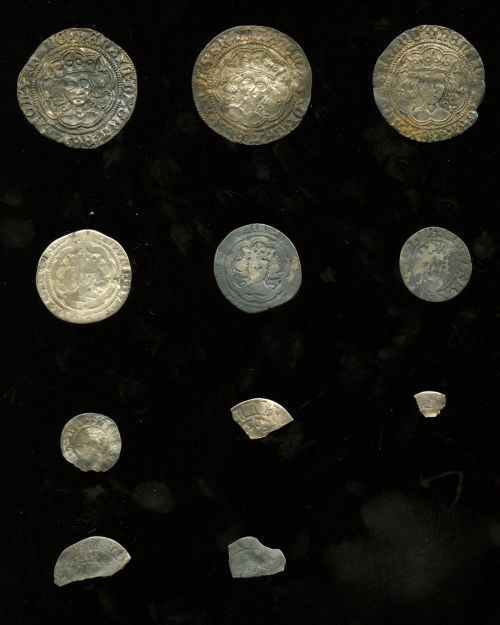Jennet Edwards, Museum Assistant, Clitheroe Castle Museum shares more of the details of this fascinating group of late medieval silver coins.
Having explored the finding of the Mitton Hoard in a previous article here, I will now endeavour to explain what it is and where you can see it.

Image copyright LCMS
The bulk of the Mitton Hoard is in Clitheroe Castle Museum; 27 of the 41 coins can be found here on display to the public. All 27 of these coins were found in 2006 near Mitton and were all English silver coins (there are Calais coins here but at the time Calais was considered English territory). They consist of:
1 groat and 1 penny of Edward III, 4th Coinage (1351-77)
3 pennies of the mid or late 14th century
1 groat and 6 pennies of Henry V (1413-22)
9 groats; 3 halfgroats; 1 penny and 2 halfpennies of Henry VI, Annulet issue (1422-7)
So, what does this tell us? Firstly, it is helpful in establishing the date. In locating the most modern coin in the hoard we know that the hoard cannot possibly predate that coin. In this case the most modern coin would be one of the Henry VI coins, meaning that the hoard can be no earlier than Henry VI and could possibly date from the Wars of the Roses. This may give us a potential reason why the hoard was abandoned and why the person that left it was unable to recover it. With the political turmoil, the previous owner of the coins may have been unable to return to the area and eventually, with time, the location was lost.
Some of the older coins have been clipped, where small pieces of silver were trimmed away from the edge of the coin. This was illegal and had severe penalties. However, the coins would still have been accepted if they weighed the standard weight or more. A new standard weight was introduced in England in 1412 and the clipped coins do fit this standard so could still have been in circulation at this time. It’s possible that the complete hoard was assembled at one time, rather than being slowly added to over many years.

Image copyright LCMS

part of LANMS.2007.2
Image copyright LCMS
The large portion of the Hoard was discovered in July 2006 but later that year, two other medieval silver coins were found in the same location. These were:
A silver groat of Henry VI, Annulet issue (1422-7), Calais mint.
A silver penny, York mint, probably 14th century but details uncertain.
The penny was very difficult to identify as it was heavily clipped, making it impossible to make out the name of the issuing king. It also has some interesting designs for a coin at the time. These two coins have not yet been on display.
Clitheroe Castle Museum was refurbished in the summer of 2009, but mere months later, 11 more coins and coin fragments were discovered in the same location and were determined by experts to be part of the same hoard. Some of these coins were even earlier than the ones found in 2006, some going back as far as Edward I.

Image courtesy of The British Museum under Creative Commons license BY-SA
Three coins are either Edward I or Edward II:
1 silver penny (1279-80) London (a fragmented piece)
1 silver penny (.1306-10) Canterbury
1 silver penny mint uncertain (a fragmented piece)
Another two are Edward III coins (1351-77):
2 Half-groats from London but one was minted 1351-2 and the other 1352-3
1 Richard II Halfpenny, London
3 Henry VI Groats Annulet (1422-7), Calais
And two coin fragments are foreign coinage:
2 Sterling Gaucher de Chatillon (1313-22) Florennes. Probably, though not necessarily, from the same coin.
These two fragments are particularly interesting as they are the only indication of foreign coinage in the hoard. Up until this discovery the coinage had been entirely English. This coin is French (minted in modern day Belgium).
Coins of this type are not unknown in England, and it is of a type of coin known as a “Continental Imitation Sterling” that looks very like an English coin but is not. It could potentially have been passed as an English coin, problematically as the coin had a lower quality of silver than many English coins of the time. So, it may be possible that either maliciously or by accident this coin (or coins) had entered English circulation and may have been mistaken for English coinage by someone merely glancing at it.
When all the parts of the hoard are considered together, we can see that the coins span a period of over 140-150 years. This gives some indication of how long coins could remain in circulation.
References
Further information about the various parts of the hoard can be found on the database of the Portable Antiquities Scheme (PAS):
https://finds.org.uk/database/artefacts/record/id/468093
https://finds.org.uk/database/artefacts/record/id/192579
You can also visit Clitheroe Castle Museum to see 27 coins from the hoard. Find out when the museum is open here.

One response to “The Mitton Hoard: Part II ”
A really good continuation of the first article. I like they way it tells you what was going on in the country at the time. I was wondering what was happening in the castle during that period?
LikeLike